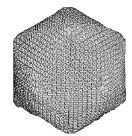Plant Pathology Department
Document Type
Article
Date of this Version
2-2006
Citation
PNAS, April 4, 2006, vol. 103, no. 14, pp. 5355–5360.
Abstract
Fast and selective transport of water through cell membranes is facilitated by water channels. Water channels belonging to the major intrinsic proteins (MIPs) family have been found in all three domains of life, Archaea, Bacteria, and Eukarya. Here we show that Chlorella virus MT325 has a water channel gene, aqpv1, that forms a functional aquaglyceroporin in oocytes. aqpv1 is transcribed during infection together with MT325 kcv, a gene encoding a previously undescribed type of viral potassium channel. Coexpression of AQPV1 and MT325-Kcv in Xenopus oocytes synergistically increases water transport, suggesting a possible concerted action of the two channels in the infection cycle. The two channels operate by a thermodynamically coupled mechanism that simultaneously alters water conductance and driving force for water movement. Considering the universal role of osmosis, this mechanism is relevant to any cell coexpressing water and potassium channels and could have pathological as well as basic physiological relevance.


Comments
© 2006 by The National Academy of Sciences of the USA. Used by permission.